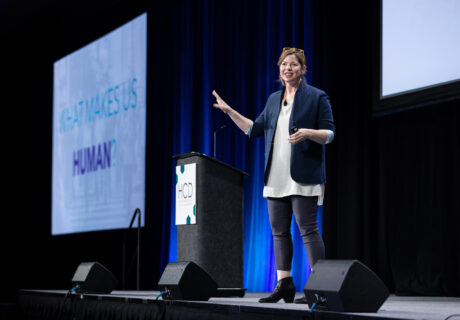HCD Expo 2021 Keynote: Meaningful Moments
An inspiring vision for the future was painted by Kate O’Neill, CEO of KO Insights and author of “Tech Humanist,” in her opening keynote session, “A Future So Bright,” at the 2021 Healthcare Design Expo & Conference in Cleveland in October.
O’Neill said it’s not uncommon to anticipate a future with scary, overwhelming scenarios—think pandemics, climate disasters, and political and geopolitical unrest. And emerging technology is often cited as a contributor to such fears.
Instead, she said, technology offers tremendous opportunity to help solve human problems while offering better human connectedness. Rather than fear the future, she asked attendees to instead think how they can help humanity prepare for an increasingly technology and data-driven future, where the physical world connects to the digital world. “How can you think more excitedly about how you’ll use technology to create more meaningful spaces?” she said.
To help guide that journey, she offered three pillars for bringing a brighter future to the built environment: building our best technology, growing our best businesses, and becoming our best selves.
Noting that part of what it means to be human is to crave meaning, O’Neill said it’s important to frame technology through this lens, focusing on how technology and data can make the world better for people both now and in the future. In healthcare, she said, that may mean thinking about the best futures for the most people.
Discussing how to grow better businesses, O’Neill said the focus shouldn’t be on a technology transformation but a “data transformation” that uses human data to optimize business. She added that when attendees hear the word “data” they should think “people,” including their motivations and desires.
Looking to create the best technology, O’Neill said technology solutions shouldn’t be viewed as either good or bad, but they do have risks. “Humans cannot leave meaning up to the machines,” she said. For example, subtle nuances are not a strong suit of artificial intelligence (AI), which O’Neill illustrated by showing a slide with images of puppies and muffins, many of which looked similar and would be hard for a computer to figure out. Humans, however, can draw on sense memory to make contextual decisions to figure out what’s what.
To get to our best technology, she noted, we need to integrate the best of technology with the best of humans to build “empathic, meaningful human experiences.” Furthermore, she noted, it’s important to have diverse perspectives involved in project teams to make inclusive human experiences. “Machines are what we encode of ourselves,” including our biases and values, she added.
In wrapping up, O’Neill reiterated that a tech-driven future with more meaningful and integrated experiences shouldn’t be scary. “We have agency and power—it will be what we make it.”

